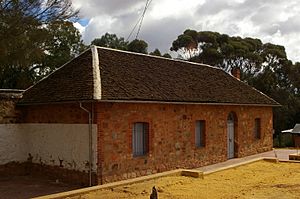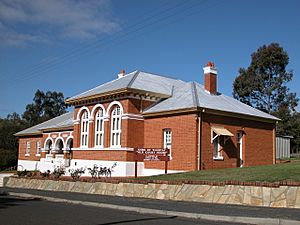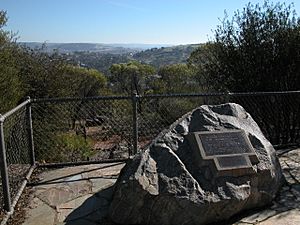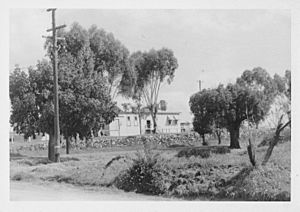Toodyay, Western Australia facts for kids
Quick facts for kids ToodyayWestern Australia |
|
|---|---|
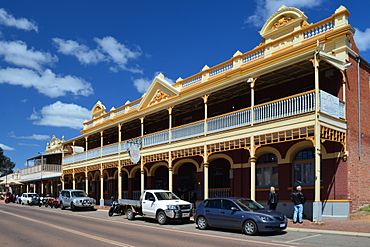
View of Stirling Terrace, 2013
|
|
| Established | 1860 |
| Postcode(s) | 6566 |
| Area | [convert: needs a number] |
| Location | |
| LGA(s) | Shire of Toodyay |
| State electorate(s) | Moore |
| Federal Division(s) | Pearce |
Toodyay (pronounced 'too-jay') is a town in Western Australia. It sits on the Avon River. This area is part of the Wheatbelt region. Toodyay is about 85 kilometres (53 mi) north-east of Perth, the capital city.
The first European settlers arrived here in 1836. The town you see today was built in the 1860s. This happened after floods damaged the original settlement. Toodyay is connected to Perth by both railway and road. In the 1860s, a famous person named Moondyne Joe lived here.
Contents
Discovering Toodyay's Past
What Does "Toodyay" Mean?
The name "Toodyay" has an interesting history. It probably comes from the Indigenous Noongar language. In 1834, it was written as "Toodye." Maps from 1836 called it "Duidgee."
The local council says "Toodyay" might mean "place of plenty." This refers to how rich and fertile the land was. It also points to how reliable the Avon River was for water. This meaning has been a long-held belief in the community.
Other ideas for the name exist too. One research project suggests it means "today it is misty and foggy." Another idea is that the name sounds like a birdcall. This could be from a bird like the restless flycatcher. The name "Duidgee" is still used today. You can find it in the beautiful "Duidgee Park" by the river.
The Ballardong People of Duidgee
Before Europeans arrived, the Toodyay area belonged to the Ballardong Noongar people. Their land stretched far across the region. The group living near Toodyay likely had about 100 people. They lived along the Avon River.
The Avon River at Toodyay was very important for food. The Ballardong people used it for thousands of years. It was also part of the journey of the Wagyl, a river serpent in their stories. The Wagyl would travel underground between special water spots.
Old Toodyay: The First Settlement (1836-1860)
The Avon River valley was explored by Ensign Robert Dale in 1830. This led to more settlers coming to the area. One of these was James Drummond, a botanist. He built his home, Hawthornden, a few kilometres north.
The first village of Toodyay was set up in 1836. It was one of the earliest inland settlements in Western Australia.
Newcastle: A New Beginning (1860-1910)
The first townsite often flooded. Because of this, people decided to move the town. A new town was built on higher ground, about 2 kilometres (1.2 mi) upstream. This new settlement was named "Newcastle" in 1860. The original village then became known as "Old Toodyay."
The Newcastle Gaol (jail) was finished in 1864. It was used as a state prison until 1909. Today, it is a preserved heritage building. You can visit it as the Old Gaol Museum.
In 1870, a flour mill called Connor's Mill was built. It used steam power to grind grain into flour. Later, it even generated electricity for the town! Today, the mill is a museum. It shows how flour was made and is part of the Toodyay Visitor Centre.
Toodyay Since 1910
In May 1910, the name "Newcastle" caused confusion. There was another big city called Newcastle in New South Wales. So, the town was renamed "Toodyay." The original settlement became "West Toodyay."
The Heritage Council of Western Australia lists many historic places in Toodyay. These include old cottages, shops, churches, and railway buildings. Some important buildings are the Gaol, Connor's Mill, and the old Toodyay Post Office. The main street, Stirling Terrace, has many historic shops and homes. They create a special look called the Stirling Terrace Streetscape Group.
The current Toodyay District High School opened in 1954. It replaced an older school building from 1886. In 1986, the movie Shame was filmed in Toodyay.
Famous People from Toodyay
In 1861, a well-known person named Moondyne Joe was held in Toodyay. He had been caught for stealing a horse. But he managed to escape! After more adventures, he returned to Toodyay in 1865. He was looking for supplies to try to travel across the country. The town now celebrates his story with the annual Moondyne Festival. It's a fun event that looks back at this part of Toodyay's past.
Visiting Toodyay
-
- See also Toodyay pioneer heritage trail
Toodyay has been a popular place for visitors for a long time. It has many places to stay and a rich history. The story of Moondyne Joe and the Old Gaol are big attractions. Toodyay is only about an hour's drive from Perth. This makes it a great spot for a day trip or a short holiday.
Many people enjoy driving the scenic Toodyay Road. This route goes through beautiful areas like Gidgegannup and the Chittering Valley. Other fun places to visit include olive oil farms and lavender farms. There are also hotels, restaurants, and caravan parks. You can even visit an emu farm or a public archery park!
Getting Around Toodyay
Railways
In the past, Toodyay was connected to the main railway line at Clackline. This line then went on to other towns. In 1966, the main railway line was changed. It now runs directly through Toodyay.
Toodyay railway station is still active today. You can catch passenger trains like the AvonLink, MerredinLink, and Prospector here. These trains travel between Perth and places like Northam and Kalgoorlie.
Roads
Toodyay Road connects Toodyay to Perth. It runs south-west to the Great Northern Highway. In Toodyay, this road becomes Stirling Terrace, the town's main street.
Other important roads lead out from Toodyay:
- Clackline Toodyay Road: Heads south to Clackline.
- Northam Toodyay Road: Goes south-east to Northam.
- Goomalling Toodyay Road: Travels north-east to Goomalling.
- Bindi Bindi Toodyay Road: Heads north to Calingiri.
- Bindoon Dewars Pool Road: Goes north-west to Bindoon.
- Julimar Road: Heads west to Chittering.
Toodyay is also the start of the Avon Historic Tourist Drive. This scenic drive follows the Avon River south to Beverley.
Motor Racing
Toodyay has even hosted motor racing! In 1947, a race meeting took place on the town's streets. The cars raced along Stirling Terrace, Henry Street, Duke Street, Fiennes Street, and Templar Lane. The main race was the Toodyay Speed Classic.
Today, Toodyay is part of the Quit Targa West car rally. This exciting event usually happens on a Saturday each year.
Waterways
Toodyay is located on the Avon River. This river flows into the Swan River in Perth. Each year, the town hosts the annual Avon Descent. This event sees many different types of boats and crafts race down the river. The race starts in Northam and passes through Toodyay.
Bushfires in Toodyay
Toodyay, like many places in Australia, can be affected by bushfires. These fires are common during the hot summer months. People have reported significant bushfires in the area since as early as 1853. The community works hard to manage and prevent these fires.
Sometimes, fires have started from things like railway lines or power lines. For example, in 1909, a fire started near Coondle from a train. It burned a large area of land. More recently, in December 2009, a major bushfire affected areas around Toodyay. Many people worked together to fight the fire and help the community recover.
Toodyaypedia: Learning About History
Since 2013, the local council and the Toodyay Historical Society have worked with Wikipedia editors. They create and update Wikipedia articles about Toodyay's history. This includes articles about old buildings and important people.
You might even see special plaques on some buildings in Toodyay. These plaques have QR codes. If you scan the code with a phone, it will take you to the Wikipedia article about that building! It's a cool way to learn about Toodyay's past.



